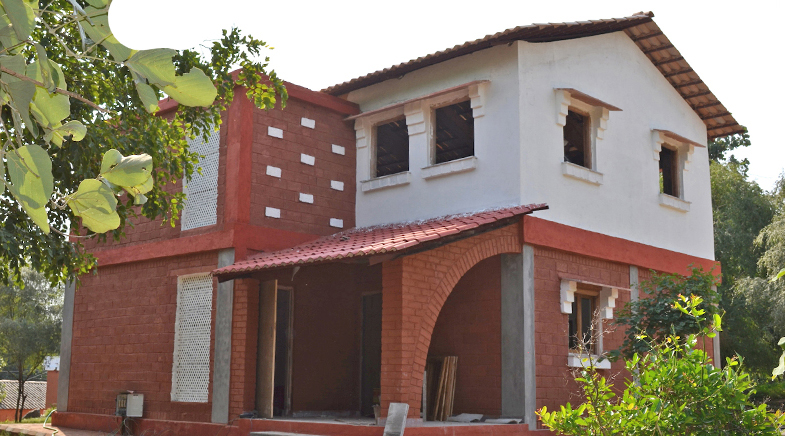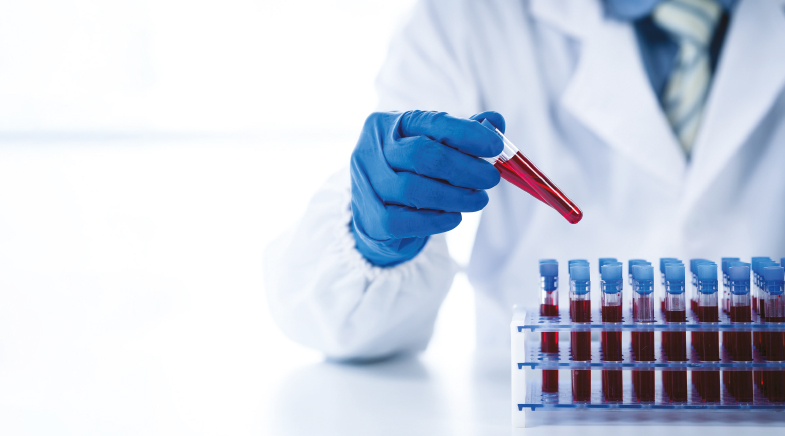The science is sound
-
- from Shaastra :: vol 04 issue 06 :: Jul 2025

Sound waves are being increasingly channelled to probe nature, with significant potential applications.
Martin Gruebele and Carla Scaletti are musicians from Illinois: Gruebele plays the organ pipe, and Scaletti the harp. Their paths didn't cross at a concert hall, though. Gruebele, a biophysicist and chemist at the University of Illinois Urbana-Champaign, wanted to investigate protein dynamics using sound. Stephen Taylor, Professor of Music at the university, connected Gruebele with Scaletti, a music composer and technologist. Their first discussions centred on the idea of converting protein dynamics data into sound and using it to teach biophysics in the classroom.
Gruebele's musical tastes, which veered towards the intellectual rather than the emotional, had led him to the idea of sonification, the practice of turning data into sound. He had been especially drawn to the structured compositions of Johann Sebastian Bach, preferring them over more emotionally driven music like that of Franz Liszt. Scaletti, who had no understanding of protein folding, took online lectures by Gruebele to learn the subject. A year and a half ago, she modified a piece of software called Kyma (meaning 'wave' in Greek), which she developed three decades ago and which translates data into sound (bit.ly/protein-sonification), to work on protein data.
Proteins, which are chains of amino acids folded into a three-dimensional shape, are flexible structures with a dynamic environment around them. Scaletti's Kyma captured the sounds of hydrogen bonds forming and breaking as proteins folded and unfolded, while her team created 3D animations, with each bond being assigned a specific pitch. "... I could listen to hydrogen bonds forming and breaking in the loops and recognise a pattern, (whereas) looking at the video did not show me anything visibly coherent," says Gruebele. "That's when I realised (that) sound can be more effective than sight for the right things."
Through sonification, the team noticed that folding occurred directly sometimes, which they termed a "highway"; at other times, it involved delays or reversals (called a "meander" transition). The sound allowed them to perceive these distinctions: a direct folding had a fast, smooth sonic profile, whereas meandering transitions had more erratic sound patterns. The team speculated that these variations related to which hydrogen bonds formed and when. "We picked a problem where... visualisation is very difficult but listening to it is actually quite easy," says Gruebele.
AN ACOUSTIC MICROSCOPE
Sound became a liberator for Mathieu Padlewski, a condensed matter physicist at École Polytechnique Fédérale de Lausanne (EPFL), Switzerland. He had become frustrated by the difficulties of studying quantum phenomena in densely packed atoms. He came across a paper by physicist Julian D. Maynard at The Pennsylvania State University, which showed that sound could be the tool to understand the behaviour of atoms within condensed matter. "After reading the paper, I thought it was cool," says Padlewski. "We can use acoustics as a tool like (an) analogue microscope to look through condensed matter systems."

Padlewski and his collaborators Romain Fleury and Hervé Lissek – both researchers at EPFL – wanted to see how atoms interact with one another. "Quantum waves are waves after all, so why not model them with sound?" Padlewski asked himself. In the quantum world, an electron can be both a particle and a wave at the same time. Also, two electrons can behave as a single entity, in a phenomenon called entanglement. Padlewski and his colleagues created acoustic analogues of electron waves in their labs (bit.ly/quantum-acoustics) by building on the ideas of Pierre Deymier, Professor of Materials Science and Engineering at The University of Arizona, who used sound wave superpositions to create analogues to quantum entanglement.
The EPFL team built a special sound-based metamaterial – metamaterials are synthetic materials with properties not found in natural materials – using 16 small cubes connected in a line. These cubes, called acoustic atoms, can function as speakers and microphones. When sound waves are passed through this set-up, the waves move smoothly at low sound volume. Energy pools up in the centre at higher volumes, capturing a superposition state between two sound atoms.
Instead of using a full set-up, Padlewski focused on just two speakers. Exciting the tube at its basic frequency creates "state 0", while the first harmonic gives "state 1". Both states can exist at the same time, forming a superposition. Unlike quantum systems, this superposition can be directly observed using the instrument. The design of their instrument is like the cochlea in the human ear, which detects different sound frequencies. This set-up could help medical scientists study hearing problems like tinnitus. The aim of the EPFL scientists is to make building blocks for quantum computer analogues using sound. "We're playing on this aspect of entanglement analogously, but we have to be careful because I don't want to upset the quantum computing folks," says Padlewski.
PAINTING WITH SOUND
Utkan Demirci, an acoustic bioengineer and a Professor of Radiology at Stanford University, had developed a professional interest some time ago in the patterns formed on the surface of a fluid by sound waves. While working with his cardiologist colleague Sean Wu to study tightly packed heart cells, Demirci returned to an old idea: Faraday waves. These were first observed by British scientist Michael Faraday, who noticed that sound waves reflecting and colliding on a liquid surface can create standing waves. Some points remain still while others move, forming beautiful, symmetric patterns known as cymatics.

Heart cells are packed tightly in the human body: around 100 million can fit into the volume of a sugar cube. Being so close helps them talk to each other and beat together like one unit. But it presents a challenge for scientists who build heart tissue. Demirci realised that Faraday waves were a good tool to engineer the heart tissue. He got a postdoctoral student with expertise in acoustics to join his lab. This group generates controlled vibrations using pistons and ultrasonic transducers. The heart cells naturally aggregate over a membrane at nodes of minimal movement, creating different patterns with different frequencies. "The shape can be changed in just a few seconds by turning a knob to change the sound, and the cells shift into a new arrangement, right before your eyes," says Demirci.
The design of Padlewski's instrument is like the cochlea in the human ear. This set-up could help medical scientists study hearing problems.
Demirci believes that this method can help researchers better study heart disease and test new drugs. In the future, their lab-grown heart tissue could even be used as patches to repair damaged parts of the heart, such as after a heart attack. This method could also help in healing bones and cartilage, growing new tissues, and quickly testing medicines using dense cell clusters. Its speed and accuracy in putting cells together help. In the future, the team will attempt to add tiny blood vessels to bring oxygen and nutrients to the tissue, making it even more like a real heart.
In a paper published in Nature early in 2025 (go.nature.com/3ZKAOlE), Demirci and his collaborators described a flexible sound-based surface that can trap and move tiny particles in fluids with high precision. It uses special membranes to create adjustable sound waves that push particles into place. Using the method, they can capture and concentrate beads and cells flowing in tiny channels, making it useful for fast biological tests and for sorting rare cells. The system is considered safe for living cells, and works well in building particle structures or studying individual cell behaviour.
LIFTING BY SOUND
Standing waves in two dimensions can form beautiful, symmetrical patterns. In three dimensions, the same waves can do something even more striking: they can levitate and hold objects in space. This phenomenon caught the attention of Asier Marzo, a physicist at the Public University of Navarra, Spain. Marzo was introduced to acoustic levitation while working with Sriram Subramanian's group at University College London (UCL). Subramanian encouraged him to think beyond virtual elements and explore ways to manipulate the real, physical world.
Marzo first built small acoustic levitation devices that could suspend objects like styrofoam balls or water droplets, mainly for demonstrations, but he moved on quickly to more advanced applications. In research published in Science Advances in February 2025 (bit.ly/plasma-levitation), Marzo's team demonstrated how acoustic levitation could be used to control plasma, the fifth state of matter, made of charged particles. Plasma creates sparks that can power devices and kill bacteria, or be used in welding. However, these sparks usually form in unpredictable ways and are hard to control. While lasers can guide them, they require high power and are difficult to manage.

Marzo's team showed that ultrasound can safely and precisely guide plasma sparks — even around obstacles. After months of investigation, they found that the spark heats the surrounding air, making it lighter; ultrasound waves then move this heated air, guiding the spark along a controlled path. This technique has many practical uses. It can direct sparks in welding or combustion, even onto non-conductive materials like plastic, eliminating the need for shielding gases or grounding wires. Since the ultrasound field is controlled by software, sparks can be steered quickly and accurately. This enables precise surface modification and sterilisation, even in hard-to-reach areas.
Acoustic levitation is also finding applications in microelectronics, where tiny and delicate components are too fragile for traditional handling. Companies like Aenitis and AcoustoFab are using the acoustic levitation technique. Aenitis uses it in precision cell handling millifluidic systems; AcoustoFab offers solutions for lab automation, enabling contamination-free sample preparation and analysis using acoustic levitation.
Additionally, Marzo and his team built a levitator using 35 ultrasonic speakers arranged in a spherical shape, each operating at 40 kHz. The sound field in the centre was strong enough to suspend objects weighing up to 50 milligrams, including both spherical and irregular particles. They tested it with various materials, such as liquid droplets and dust particles, useful in research on atmospheric and cosmic dust.
This work caught the interest of scientists in other fields as well. Romain Bordes, an applied chemist at Chalmers University of Technology in Sweden, began building simple acoustic levitators as a hobby. He found it useful for studying liquid interfaces without contact, which is vital in surface chemistry, leading him to create a Nuclear Magnetic Resonance (NMR) system on a levitated droplet (go.nature.com/4mZnRif). This was a way to study molecules without a container.
"One of our main questions at the start was whether we could get the same accuracy and resolution from an NMR spectrum using a self-standing droplet as the traditional method," says Bordes. "I'd say that our approach can match the performance of standard methods."
SONG OF STARS
"Stars make music, vibrations that come from deep inside them," says Christopher Lindsay, an astronomy researcher and a PhD candidate at Yale University. He studies these starquakes channelling asteroseismology, the field that helps scientists understand what's happening inside stars by listening to their natural oscillations. "Stars like the Sun have layers, with energy from nuclear fusion in the core moving outward. This movement causes vibrations, like a bell ringing, that can be detected by measuring surface motions," says Lindsay.
In a recent collaborative work (bit.ly/M67-sound), Lindsay listened to sounds from the open star cluster M67 (also known as the King Cobra Cluster) using space telescopes TESS (Transiting Exoplanet Survey Satellite) and Kepler. In this study of 27 stars from the M67 cluster, researchers found "small separations", or patterns of sound wave movement inside the stars. These changes seemed to be linked to a layer inside the star called the convective envelope, where hot gases constantly rise and fall. As a star ages, this layer sinks deeper, and that shift changes how the waves travel through the star. The study shows that looking at these patterns in sound waves can give better estimates of a star's age and mass.
LIGHT, SOUND, ACTION
Photoacoustics is a technique where a sharp laser pulse makes a material produce a sound. It became a key tool for Jaya Prakash, a physicist at the Indian Institute of Science. Using this technique, Prakash and his team developed a non-invasive device to measure blood glucose using light and sound (bit.ly/photo-acoustics). The system works by shining a light at a specific wavelength (1,560 nm) which glucose absorbs, in the process generating tiny sound waves. These sound waves are then detected to estimate glucose levels: the stronger the signal, the higher the glucose concentration.
Currently, the prototype of this device is prohibitively expensive, but with mass production and changes in components, Prakash expects the price could drop to below ₹40,000. He plans to replace expensive parts like nanosecond lasers with cheaper light-emitting diode (LED) arrays and use in-house ultrasound detectors to reduce costs. The final device would be about the size of a telephone. Unlike current continuous glucose monitors, which are expensive and only measure glucose in interstitial fluid, this device measures actual blood glucose, offering better accuracy. "It could also detect markers like deoxyhaemoglobin, lipids, water, melanin, and bilirubin," says Prakash.
The team is also working on combining photoacoustic and ultrasound imaging for broader uses such as cancer, brain, and heart imaging. While deeper imaging is currently difficult due to weak signals, Prakash sees strong potential for future improvements.
Since the team lacked enough volunteers for regular testing, Prakash volunteered as a test subject. He drove 15 kilometres to the lab every morning, arriving by 7.30 a.m. on an empty stomach. For four days, he and a student scanned his glucose levels before and after meals.
The system developed by Prakash's group can distinguish between diabetic and non-diabetic individuals and might eventually help calculate insulin doses instantly. By adjusting the light wavelength, the same device could detect other molecules too, making it useful for drug testing and other biomedical applications.
See also:
Have a
story idea?
Tell us.
Do you have a recent research paper or an idea for a science/technology-themed article that you'd like to tell us about?
GET IN TOUCH














